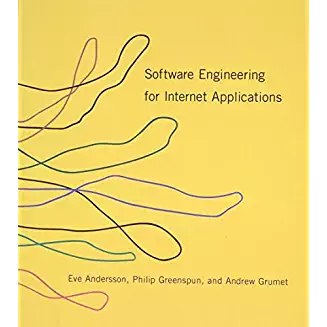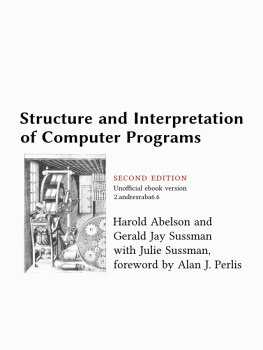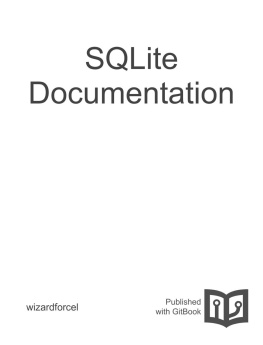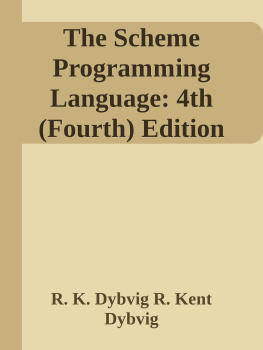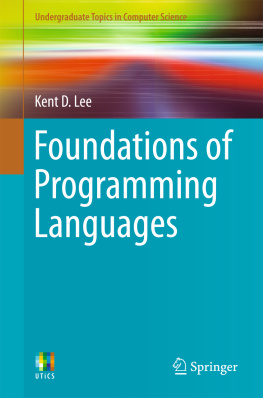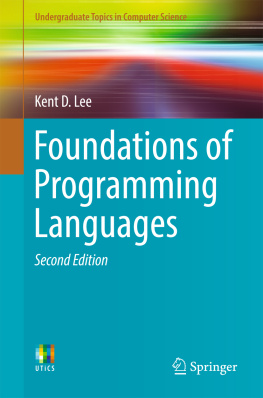it-ebooks - Programming Languages Application and Interpretation
Here you can read online it-ebooks - Programming Languages Application and Interpretation full text of the book (entire story) in english for free. Download pdf and epub, get meaning, cover and reviews about this ebook. year: 2017, publisher: iBooker it-ebooks, genre: Home and family. Description of the work, (preface) as well as reviews are available. Best literature library LitArk.com created for fans of good reading and offers a wide selection of genres:
Romance novel
Science fiction
Adventure
Detective
Science
History
Home and family
Prose
Art
Politics
Computer
Non-fiction
Religion
Business
Children
Humor
Choose a favorite category and find really read worthwhile books. Enjoy immersion in the world of imagination, feel the emotions of the characters or learn something new for yourself, make an fascinating discovery.
- Book:Programming Languages Application and Interpretation
- Author:
- Publisher:iBooker it-ebooks
- Genre:
- Year:2017
- Rating:4 / 5
- Favourites:Add to favourites
- Your mark:
- 80
- 1
- 2
- 3
- 4
- 5
Programming Languages Application and Interpretation: summary, description and annotation
We offer to read an annotation, description, summary or preface (depends on what the author of the book "Programming Languages Application and Interpretation" wrote himself). If you haven't found the necessary information about the book — write in the comments, we will try to find it.
Programming Languages Application and Interpretation — read online for free the complete book (whole text) full work
Below is the text of the book, divided by pages. System saving the place of the last page read, allows you to conveniently read the book "Programming Languages Application and Interpretation" online for free, without having to search again every time where you left off. Put a bookmark, and you can go to the page where you finished reading at any time.
Font size:
Interval:
Bookmark:
From: Programming Languages: Application and Interpretation
Please watch thevideo on YouTube.Someday there will be a textual description here instead.
Unlike some other textbooks, this one does not follow a top-downnarrative. Rather it has the flow of a conversation, withbacktracking. We will often build up programs incrementally, just asa pair of programmers would. We will include mistakes, not because Idont know the answer, but because this is the best way for youto learn . Including mistakes makes it impossible for you to readpassively: you must instead engage with the material, because you cannever be sure of the veracity of what youre reading.
At the end, youll always get to the right answer. However, thisnon-linear path is more frustrating in the short term (you will oftenbe tempted to say, Just tell me the answer, already!), and itmakes the book a poor reference guide (you cant open up to a randompage and be sure what it says is correct). However, that feeling offrustration is the sensation of learning. I dont know of a wayaround it.
At various points you will encounter this:
This is an exercise. Do try it.
This is a traditional textbook exercise. Its something you need todo on your own. If youre using this book as part of a course, thismay very well have been assigned as homework. In contrast, you willalso find exercise-like questions that look like this:
Theres an activity here! Do you see it?
When you get to one of these, stop . Read, think, and formulatean answer before you proceed. You must do this because this isactually an exercise , but the answer is already in thebookmost often in the text immediately following (i.e., in the partyoure reading right now)or is something you can determine foryourself by running a program. If you just read on, youll see theanswer without having thought about it (or not see it at all, if theinstructions are to run a program), so you will get to neither (a)test your knowledge, nor (b) improve your intuitions. In other words,these are additional, explicit attempts to encourage active learning.Ultimately, however, I can only encourage it; its up to you topractice it.
#!/bin/sh |
| plai-typed |
#lang plai-typed |
| ( define-type MisspelledAnimal |
| [ caml ( humps : number ) ] |
| [ yacc ( height : number ) ] ) |
| ( caml ) |
| ( yacc 1.9 ) |
| ( define ma1 : MisspelledAnimal ( caml ) ) |
| ( define ma2 : MisspelledAnimal ( yacc 1.9 ) ) |
| ( define ma1 ( caml ) ) |
| ( define ma2 ( yacc 1.9 ) ) |
The type names can even be used recursively, as we will seerepeatedly in this book (for instance, ).
| ( define ( good? [ ma : MisspelledAnimal ] ) : boolean |
| ( type-case MisspelledAnimal ma |
| [ caml ( humps ) ( >= humps ) ] |
| [ yacc ( height ) ( > height 2.1 ) ] ) ) |
| ( test ( good? ma1 ) #t ) |
| ( test ( good? ma2 ) #f ) |
| ( define ( good? [ ma : MisspelledAnimal ] ) : boolean |
| ( type-case MisspelledAnimal ma |
| [ caml ( h ) ( >= h ) ] |
| [ yacc ( h ) ( > h 2.1 ) ] ) ) |
Font size:
Interval:
Bookmark:
Similar books «Programming Languages Application and Interpretation»
Look at similar books to Programming Languages Application and Interpretation. We have selected literature similar in name and meaning in the hope of providing readers with more options to find new, interesting, not yet read works.
Discussion, reviews of the book Programming Languages Application and Interpretation and just readers' own opinions. Leave your comments, write what you think about the work, its meaning or the main characters. Specify what exactly you liked and what you didn't like, and why you think so.


